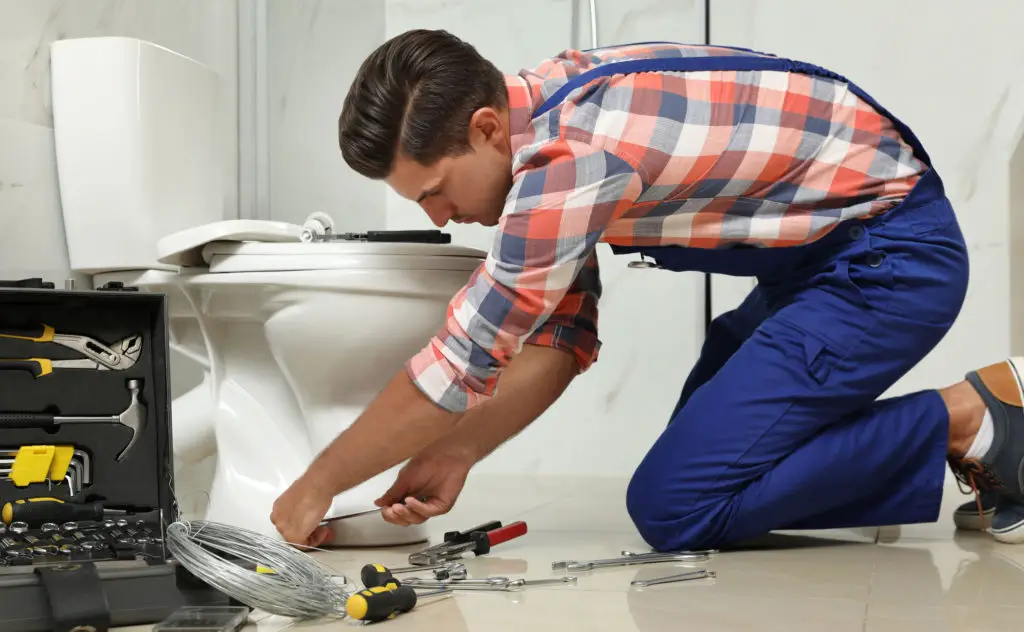
Remodeling a bathroom can be a lot of work. Often, bathrooms are small with not much room to move around, so moving the toilet might seem like a good idea, but can you move a toilet?
A toilet can be moved in a bathroom remodel. You must pay attention to where the current waste line runs compared to where the new placement will be as this can increase the workload and the cost of the project. Involving a professional will simplify the process.
Whether or not there is space underneath the bathroom can completely change the plans you have for renovations. This can be the deciding factor in whether or not moving the toilet is worth the hassle.
Can A Toilet Be Moved In A Bathroom Remodel
Bathrooms can seem extremely small, but moving the toilet to a different place can create more available space. The good news is that a toilet can be moved in a bathroom remodel. The bad news is that it will take hard work and can cost a decent amount of money.
While a bathroom may not offer many opportunities for moving the toilet, you may be able to shift the toilet, and that can make all the difference. If you are already planning to do a full bathroom remodel, it is good to move the toilet while you are remodeling. Doing so later will set you back even more financially, so if you want to move the toilet, do it while renovating.
Though remodeling a bathroom is up to you, it is good to include professionals in the renovation decisions because they know about the plumbing problems you may face and how to avoid them. They can let you know how far you can move the toilet from the stack and other similar concerns.
The next question one might ask is how to go about moving a toilet in a bathroom remodel? You will want to involve a professional in moving the toilet itself because it can be much more complicated than it looks.
Things To Consider When Moving A Toilet
There is more to consider than just where you want to have the toilet be moved to. This question is much more complicated than it seems. You may already be thinking about the available space you have to work with and while this is important and can alter the layout possibilities in the bathroom, there are other important factors.
My mom renovated our bathrooms just a few years ago. Because of the lack of space in the bathroom, she was unable to move the toilet. It was also too expensive for us at the time. We noticed, though, that our bathroom was too small to move the toilet from where it was. Its spot between the sink and shower was the only place it would fit. Allowing for proper space around the toilet and its draining system will prevent problems in the future.
Other things to consider before deciding to move the toilet include where the waste line is and what is located under the bathroom you are renovating. One may wonder why the waste line and what is below the bathroom affect where the toilet is located so much, but if either of these things is ignored, the renovations you plan on doing will not matter because you will have to redo all the renovations.
The Waste Line
To avoid redoing the plumbing in your home, it is good to know where the waste line runs. Depending on where the waste line is, you may be prevented from moving the toilet too much.
The waste line can only be so far from the toilet’s new location because that is how the toilet will drain correctly. The drain from where the toilet was must be close enough to the toilet’s new location to ensure it can drain properly.
The toilet can only be so far from the stack or vertical pipe and this will change depending on how big the pipes are. We will address this again later, so if you are still wondering how far the toilet can be moved, the answer will come when we readdress how far the toilet can be from the stack.
What Lies Under The Bathroom Affects Your Renovations
Two things can be underneath a bathroom: space or concrete. Having space below your bathroom is the best option in terms of what can be under your bathroom. If there is space underneath the bathroom, you can move the toilet almost anywhere you would like.

If there is a basement or crawl space under the bathroom, you may only be able to move the toilet a few inches before you will have to readjust the waste line. In this case, you will need the help of a professional to prevent plumbing issues in your home.
If there is a room underneath the bathroom, you may have to demolish the ceiling and the walls of the room below the bathroom. This can be strenuous and costly. Doing so will allow for the water line to be moved in the walls if the toilet is moved too far. While this can cost you serious amounts of money, the process becomes easier if you ask a professional for help.
There could also be a closed space underneath the bathroom. This can happen if you have concrete underneath the bathroom. This will prevent you from moving the toilet like you want to. In this case, you will only be able to move the toilet a few inches at the maximum.
Moving the toilet more than a few inches can result in cracking the cement under the bathroom, which is not a good thing. This can result in the foundation further cracking with time.
If there is cement under the bathroom, you can move along with other renovations, but deciding to move the toilet anyway is simply not wise. The rest of the renovations will not be affected unless you decide to change where the sink is located in the bathroom as well.
If there is a concrete base, focus on changing the color scheme of the bathroom or the flooring. Doing many more renovations in such a case will be nearly impossible. Make sure you know what your house is like before you begin cutting into the floor.
Distance From the Stack
When we refer to a stack in plumbing, we are referring to the vertical drainage system. The stack allows for draining and ventilation for the smaller pipes.
A toilet can only be so far from the stack before the drainage system cannot work properly. For example, if the pipe has a diameter of 3 inches, the toilet should not be more than 6 feet from the stack. The larger the diameter of the pipe, the farther away the toilet can be. The drop rate just needs to be 1/4 inch per horizontal foot. The toilet can be closer to the stack, but it should not exceed the limits placed.
You may wonder why the distance from the stack is so crucial, but if the toilet is too far from the stack, you will be spending much more money on repairs than you ever did in the remodeling.
Moving The Toilet
There is a series of steps you should follow to move the toilet in your bathroom. First things first, you will need to shut off the water. Forgetting to do so will result in quite a large mess because the water cannot be flowing through the pipes if you remove a valuable piece of the line.
Next, you can remove the toilet. If you plan on reinstalling the same toilet, you will need to avoid chipping the toilet, so remove the toilet carefully. I suggest having a specific place where you can move the toilet quickly and easily that will be out of the way enough for you to continue with the project.
You will need access to the pipes, so if there is a floor beneath the bathroom, you may need to cut into the ceiling and replace it. You will want to use a circular saw blade 1/8 inch thicker than the floor below the bathroom.
Unscrew the toilet flange from the floor. This is what keeps the toilet connected to the drain pipes below it. After unscrewing the flange, cut the old toilet bend as close as you can to the stack.

You will want to make sure the new toilet drain is at least 15 inches from all the walls around it to ensure there is proper draining once you finish renovating the bathroom.
Run the new drain pipe from the toilet’s new location to the vent stack. Glue a 90-degree closet bend on the drain pipe. The closet bend will be just under the toilet, allowing the system to drain correctly.
Add PEX pipes to the water supply. You will just be continuing it, not replacing it. The next step will require you to finish the flooring and fitting the flange to the floor. After you have fit the flange, you will be able to install the toilet the rest of the way. Make sure the toilet is installed correctly before turning the water back on.
